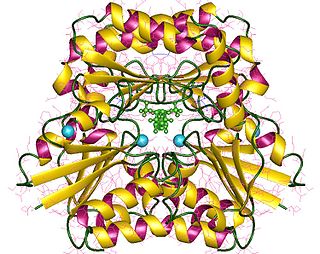
In biochemistry, a kinase is an enzyme that catalyzes the transfer of phosphate groups from high-energy, phosphate-donating molecules to specific substrates. This process is known as phosphorylation, where the high-energy ATP molecule donates a phosphate group to the substrate molecule. This transesterification produces a phosphorylated substrate and ADP. Conversely, it is referred to as dephosphorylation when the phosphorylated substrate donates a phosphate group and ADP gains a phosphate group. These two processes, phosphorylation and dephosphorylation, occur four times during glycolysis.
Isomerases are a general class of enzymes that convert a molecule from one isomer to another. Isomerases facilitate intramolecular rearrangements in which bonds are broken and formed. The general form of such a reaction is as follows:
Phosphotransferases are a category of enzymes that catalyze phosphorylation reactions. The general form of the reactions they catalyze is:

In biochemistry, flavin adenine dinucleotide (FAD) is a redox-active coenzyme associated with various proteins, which is involved with several enzymatic reactions in metabolism. A flavoprotein is a protein that contains a flavin group, which may be in the form of FAD or flavin mononucleotide (FMN). Many flavoproteins are known: components of the succinate dehydrogenase complex, α-ketoglutarate dehydrogenase, and a component of the pyruvate dehydrogenase complex.
Flavin reductase a class of enzymes. There are a variety of flavin reductases, which bind free flavins and through hydrogen bonding, catalyze the reduction of these molecules to a reduced flavin. Riboflavin, or vitamin B, and flavin mononucleotide are two of the most well known flavins in the body and are used in a variety of processes which include metabolism of fat and ketones and the reduction of methemoglobin in erythrocytes. Flavin reductases are similar and often confused for ferric reductases because of their similar catalytic mechanism and structures.
In enzymology, an FMN reductase (EC 1.5.1.29) is an enzyme that catalyzes the chemical reaction
In enzymology, a β-phosphoglucomutase is an enzyme that catalyzes the chemical reaction
In enzymology, a phosphoglucomutase (glucose-cofactor) is an enzyme that catalyzes the chemical reaction

In enzymology, a phosphomannomutase is an enzyme that catalyzes the chemical reaction
In enzymology, a phosphopentomutase is an enzyme that catalyzes the chemical reaction
The enzyme FAD-AMP lyase (cyclizing) catalyzes the reaction
In enzymology, a FAD diphosphatase (EC 3.6.1.18) is an enzyme that catalyzes the chemical reaction
In enzymology, a FMN adenylyltransferase is an enzyme that catalyzes the chemical reaction
In enzymology, a glucose-1-phosphate phosphodismutase is an enzyme that catalyzes the chemical reaction
In enzymology, a glycerol-3-phosphate-glucose phosphotransferase is an enzyme that catalyzes the chemical reaction
In enzymology, a phosphoglucokinase is an enzyme that catalyzes the chemical reaction
In enzymology, a polyphosphate-glucose phosphotransferase is an enzyme that catalyzes the chemical reaction.

In enzymology, a riboflavin kinase is an enzyme that catalyzes the chemical reaction
In enzymology, an UDP-glucose—glycoprotein glucose phosphotransferase is an enzyme that catalyzes the chemical reaction

The prokaryotic riboflavin biosynthesis protein is a bifunctional enzyme found in bacteria that catalyzes the phosphorylation of riboflavin into flavin mononucleotide (FMN) and the adenylylation of FMN into flavin adenine dinucleotide (FAD). It consists of a C-terminal riboflavin kinase and an N-terminal FMN-adenylyltransferase. This bacterial protein is functionally similar to the monofunctional riboflavin kinases and FMN-adenylyltransferases of eukaryotic organisms, but only the riboflavin kinases are structurally homologous.





